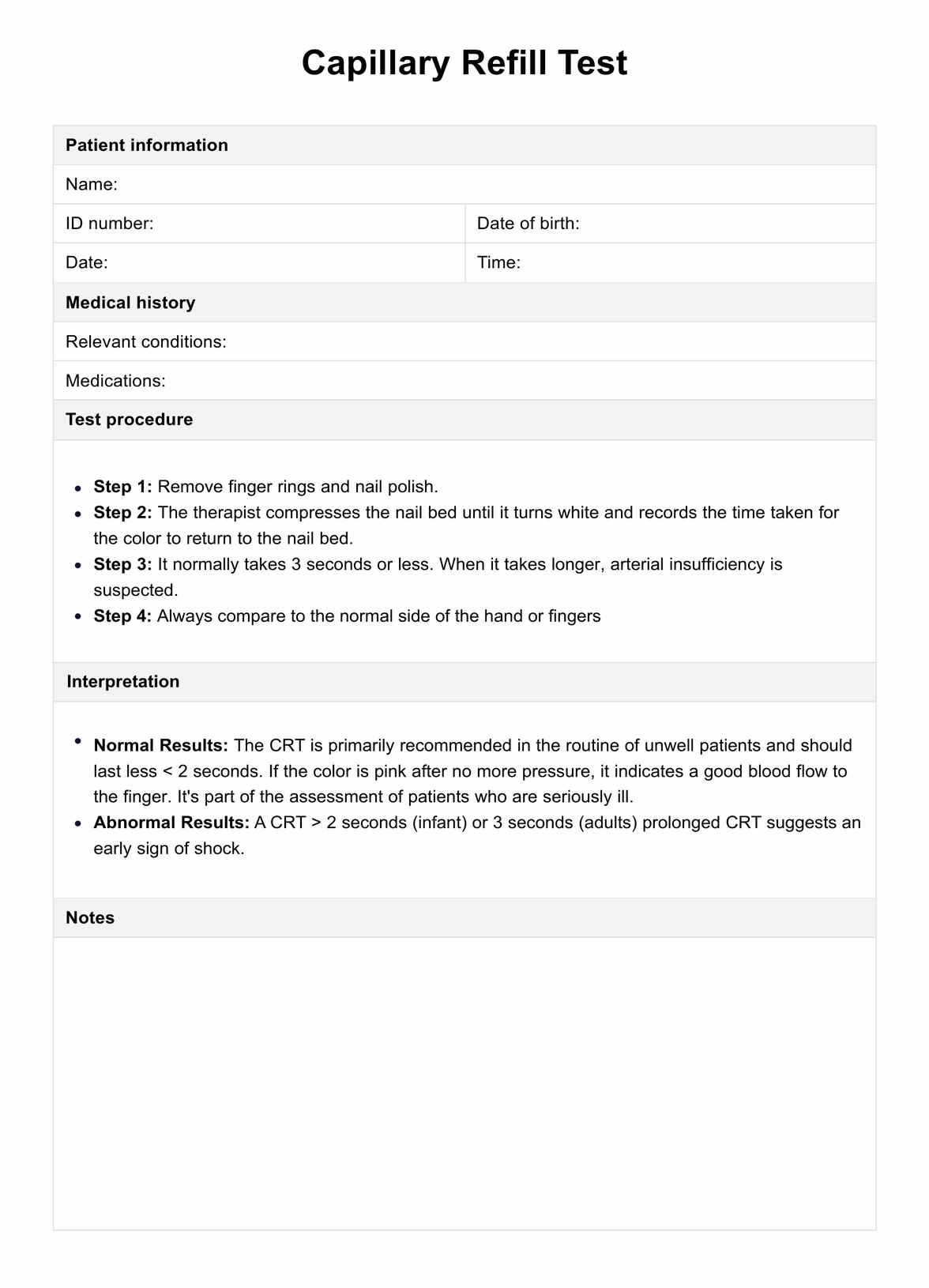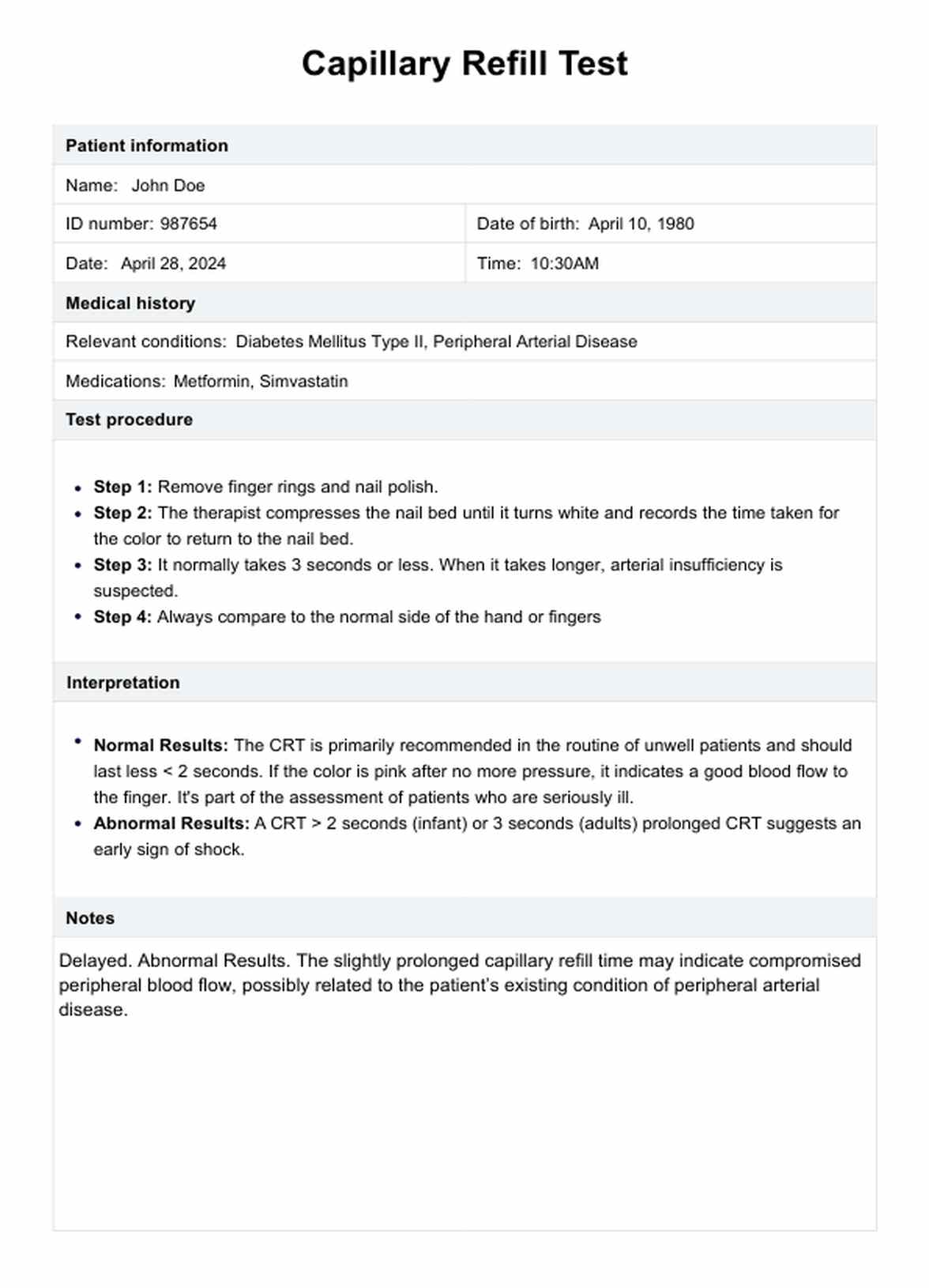Capillary Refill Test
Explore the Capillary Refill Test's clinical significance, methodology, and diagnostic applications in medical practice.


What is a Capillary Refill Test?
The Capillary Refill Test checks blood flow by pressing on the nail bed or skin until it whitens, then observing how quickly color returns. Usually, the color should return within 2 seconds. A delay may suggest shock, dehydration, or poor blood flow.
The refill time is a quick test to assess blood flow and detect changes that may indicate a severe medical condition. It's a part of the ABCDE Assessment for critically ill patients. Factors that affect the test include peripheral vascular disease, hypothermia, cold temperature, poor lighting, old age, and pressure applied during the te
Capillary Refill Test Template
Capillary Refill Test Example
What factors can affect capillary refill time?
Capillary refill time (CRT) can be affected by three main factors: physiological, environmental, and medical/clinical. These factors impact how quickly blood returns to capillaries after being pressed on. It's important to note that these factors can vary, and understanding them is crucial in assessing a patient's health.
Physiological
Physiological factors are inherent biological processes that affect blood flow through capillaries. Age, hydration levels, heart health, and blood characteristics influence them.
- Age: Older individuals might have slower capillary refill times due to decreased elasticity in their blood vessels and other age-related changes in vascular function.
- Hydration and volume status: Dehydration or shock can reduce blood volume, affecting capillary refill times. Well-hydrated individuals usually have regular refill times, while those with volume depletion may have prolonged times.
- Heart conditions: Cardiac output and function can influence CRT. Conditions that decrease cardiac output, such as heart failure or cardiac arrest, can result in slower refill times.
- Anemia and blood characteristics: Variations in blood viscosity or severe anemia can influence how quickly blood refills capillaries after pressure is released.
Environmental
External conditions and physical pressures can influence CRT measurements. These factors include the temperature and pressure of the surroundings, directly impacting blood vessel behavior. Consider the different settings and conditions in which CRT assessments are made to ensure accuracy.
- Temperature: Colder temperatures can cause peripheral vasoconstriction, leading to slower capillary refill times. Conversely, warm temperatures can cause vasodilation, potentially decreasing refill times.
- Ambient pressure: High ambient pressures, such as those experienced underwater or in a hyperbaric chamber, can affect blood flow and capillary dynamics.
Medical/clinical
Health conditions or treatments that affect blood vessels and blood flow are classified as medical or clinical factors. These factors include diseases that affect blood vessels, the impact of medications, and the techniques used for measuring CRT. These factors are significant when it comes to diagnosing and managing patients.
- Peripheral vascular disease: Conditions that affect blood flow, such as atherosclerosis or peripheral artery disease, can lead to prolonged capillary refill times.
- Medications: Certain medications that affect vascular tone, such as vasodilators or vasoconstrictors, can alter capillary refill times.
- Method of measurement: The technique and the amount of pressure applied, the body part used for assessment, and even the lighting conditions can influence the measurement of capillary refill time.
Preparations for the Capillary Refill Test
For the Capillary Refill Test, which is a quick test to assess circulatory status, here are some detailed steps to ensure accurate measurement:
- Check temperature: Ensure that the patient's hands or feet are warm. Cold extremities can affect the test results, as cold can slow blood flow. If the patient’s extremity is cold, warm it to an average temperature before testing.
- Proper lighting: Perform the test in a well-lit area. Good lighting is essential to observe color changes in the nail bed or skin.
- Apply pressure: Use your thumb or another finger to apply firm, even pressure to the nail bed or the skin if the nails are inaccessible. The pressure should be enough to blanch (turn white) the area. Hold the pressure for about five seconds.
- Observe refill time: Immediately start timing the refill duration after releasing the pressure. Normal capillary refill time is usually 2 seconds or less. This means it should take no more than 2 seconds for the color to return to the blanched area. Delays in refill time can indicate circulatory issues and may necessitate further medical evaluation.
How does our Capillary Refill Test template work?
This template records the results of a Capillary Refill Test used by healthcare professionals to assess blood flow and vascular health. Here’s how the template works:
- Patient information: This section gathers essential patient information such as name, ID number, birth date, and test date/time, linking the test to the patient's medical history.
- Medical history: Here, you list relevant medical conditions and medications the patient takes.
- Test procedure: The template outlines the steps to perform the test. To perform the test, simply press down on the nail bed until it turns white, then show how long it takes for the color to return once pressure is released. Record the time taken and compare the results with the unaffected side of the hand or fingers if applicable.
- Interpretation: This section explains what the results mean:some text
- Normal refill time: <2 seconds = good blood flow.
- Abnormal refill time: >2 seconds = possible arterial insufficiency or early sign of shock.
- Notes: Additional observations or specific circumstances during the test can be noted here.
- Follow-up actions: Based on the test results, this area documents recommended next steps or further tests.
- Signature: The healthcare professional administering the test signs off on the record, confirming the accuracy and completion of the test.
Results, interpretation, and next steps of the Capillary Refill Test
The interpretation of the Capillary Refill Time (CRT) test and the subsequent steps to take are based on how quickly color returns to the nail bed after pressure is released.
For healthy individuals, this refill process should occur in under two seconds. It indicates adequate blood flow and a well-functioning cardiovascular system that efficiently delivers blood to the extremities.
Conversely, a refill time exceeding two seconds is abnormal and may suggest poor blood circulation, potentially pointing to arterial insufficiency or as an early warning sign of shock.
Individuals with average results should be monitored continuously in a clinical setting. Abnormal results require further diagnostic tests to pinpoint underlying issues. Immediate medical attention is necessary for indications of shock or significant circulatory problems.
Healthcare providers are advised to consider CRT results alongside other clinical assessments to make well-informed decisions regarding patient care.
Benefits of using our template
Using a standardized template for documenting the Capillary Refill Test in medical practice offers several benefits that enhance clinical efficiency and patient care quality. Here are some of the key advantages:
- Consistency in documentation: The template ensures consistent documentation of each test, including methods, results, and interpretations. Maintaining uniformity is essential for creating high-quality, easily reviewable records.
- Improved communication: A standardized format aids communication among healthcare professionals, especially in multidisciplinary teams.
- Enhanced accuracy: This reduces the risk of missing important information by prompting users to record specific details, enhancing test results' accuracy, and reducing errors.
- Efficiency in record-keeping: It saves time for healthcare providers, allowing them to focus more on patient care.
- Quality control and audit readiness: Standardized documentation supports quality control and audit processes, simplifies compliance reviews, and helps identify trends or improvements in patient care.
Commonly asked questions
The Capillary Refill Test indicates the status of blood flow to tissues. It can help assess peripheral perfusion and detect circulatory or cardiovascular abnormalities.
Yes, brisk capillary refill, typically defined as a refill occurring in less than 2 seconds, is considered normal and indicates good blood flow.
The normal capillary refill time is less than 2 seconds. This indicates healthy blood circulation to the extremities.







































































































